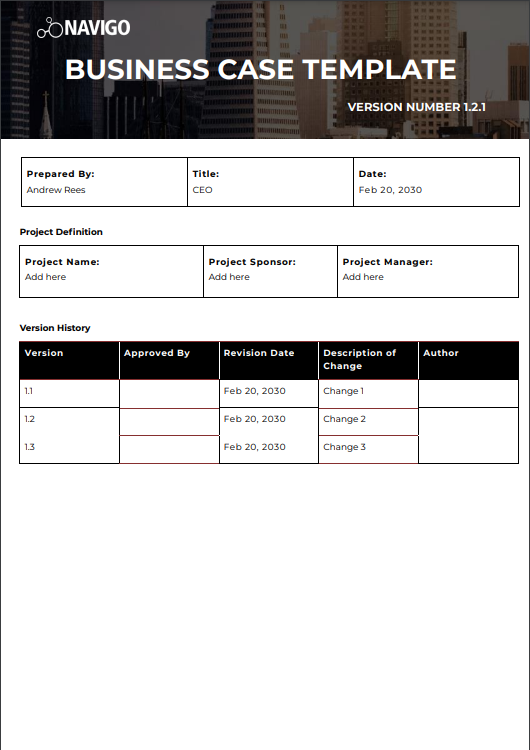[ updated: August 2024 ]
So, you’ve discovered how org charting software can improve efficiency and save your company time and resources? Now, all that’s left is to gather an expert team and pitch your idea to stakeholders. While org charting software may be an obvious winner for the HR team, Senior Leadership usually needs some convincing.
So what’s the best approach? Two words – business case.
Before you present your idea, you need a plan outlining how you will finance, sustain and execute the project. A business case will put all these in place. This article breaks down everything you need to get your org chart business case off the ground. We’ve even provided a free template to get you started.
First, let’s go back to basics. What is a business case and why is it important?
A business case brings together the benefits, disadvantages, costs and risks of the current situation and future vision, allowing the C-Suite to decide if the project is viable for the business.
We’ve recently updated our HR business case template, including a detailed structure you can use for the HR technology you are focused on. While our examples stay in the world of org charting and org design, you will be able to adpat these for your purpose.
Key Elements
- Executive Summary
- Problem Statement
- Background and key project drivers
- Options considered
- Scope (in /out)
- Stakeholder Engagement and Change Management
- Stakeholder Engagement
- Change Management
- Benefits
- Quantifiable Benefits
- Non-Quantifiable Benefits
- Implementation Plan and Risk Assessment
- Project Approach and Timing
- Risks
- Financial Analysis
- Budget Breakdown
- Operational Impact
- Approvals
- Steering Committee
- Project Endorsement
- Sponsors
Best Practices
- Engage Stakeholders: Speak with all internal stakeholders to understand and outline the measurable impacts of your solution. For example, automated reporting in org charts could save the HR team a specific amount of time, translating into annual cost savings.
- Use business terminology: Avoid HR-specific jargon, speak in terms that resonate with your audience
- Be specific: Stick to the facts and avoid fluffy language. Clarity is key
- Tailor your message: Personalise your business case to each stakeholder group, considering what matters most to them, for instance, focus on process effectiveness for HR, cost reduction for procurement and date security for IT.
| Case for HR | Case for Procurement | Case for Finance | Case for IT |
|---|---|---|---|
| Process Effectiveness | Cost | Ensuring quality is not compromised | Data Security |
| Visualisation of workforce | Reducing unnecessary spend | Compliance and Single Source of truth for Managers |
Integrations |
| Meaningful data for HR Reports | Risk and Compliance | Delivering true cost savings | Ease of use |
5 essential tips to get your business case approved
-
- Current state assessment: Before starting an HR technology project, assess what you already have. Understand the why behind the change. This is crucial for framing the problem and defining the scope of the project.
- Leverage your internal stakeholders: Engage key stakeholders early, using structured interviews and surveys to gather their insights. Document their feedback as user stories to strengthen your case.
- Talk to vendors: Don’t overlook the value of consulting your current vendors. They can help identify opportunities for improvement and provide essential documentation and financial information for your business case.
- Is it a vitamin or a pill? Don’t overlook the value of consulting your current vendors. They can help identify opportunities for improvement and provide essential documentation and financial information for your business case.
- Tell as story: Your business case is a sales document. Use storytelling to illustrate the before-and-after scenario, aligning your proposal with corporate goals. Including real-life examples and quotes to add an emotional appeal and make your case more compelling
Presenting your business case
After drafting your business case, the next step is presenting it to your stakeholders, which may include the HR director, Procurement Manager, or C-Suite. Preparation is crucial – anticipate their questions and concerns. Consider these three aspects:
Current vs future state
Show how your proposed project will positively transform your organisation. Examples include:
- Enhanced communication: Show relationships between positions and provide insights into your org hierarchy.
- Reduce HR workload: Real-time configurable org charts can ease the manual workload for HR teams.
- Improved workforce management: Gain visibility over staffing levels and easily identify vacant positions.
- Data accuracy: Make HR data accessible to the entire organisation, encouraging staff to correct errors promptly
- Support diversity and inclusion: Highlight diversity metrics within your org chart.
- Strategic decision making: Use org charts for more effective staff management, such as monitoring leave balances or span of control.
Timing
Explain why now is the right time to implement org charting software. For example, during a merger or restructuring, a visualisation tool can save significant time and effort.
Contingency costs
Address the potential costs if the company chooses not to proceed with the project. Consider the long-term impact on the organisation.
Ready to get started?
Download the template as a guide for your next business case, this template includes detailed instructions on what each section of the business case should include. Remember: The main focus should be on the solution, the implementation timeline and providing strong numbers to back your case.
|
|
By submitting this form you’re agreeing to join our mailing list. If you don’t find our communications valuable, please unsubscribe any time. For more information, see our Privacy Policy.
Want to learn more? Watch our webinar below Write a winning HR business case: 5 essential tips & tricks to learn key elements that can make or break your business case. Plus you’ll leave with practical tips you can use straight away!
Creating an org chart business case is no simple task. If you have any questions, our team would be happy to assist you along your journey. If you would like any support around this process, book a free chat with our friendly team.




